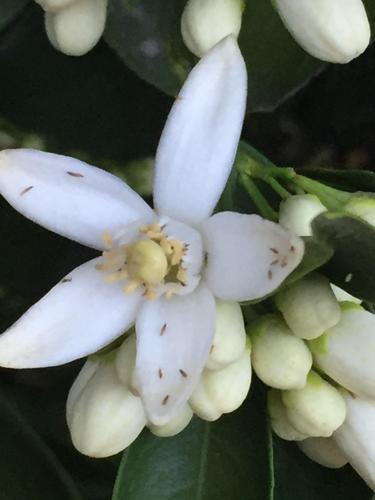Question: I am interested in identifying this unknown garden visitor. I originally ID’d it as a native bee but after closer inspection, I am not sure if this is a bee.
Answer: Your visitor is a bee mimic sometimes called a bee fly. It is a member of the fly order (Diptera) and the family Bombyliidae. As larvae, these insects are parasites of other insects. As adults, we generally see them feeding on nectar and pollen. They can’t harm humans and are not considered to be pests.
Question: I was at my doctor’s office and noticed a guy spraying pesticide on flowering plants with bees. I asked in the doctor’s office and they said the bees were flying around the door and bothering some of the patients as they came and went so they called this guy to spray the bees. Isn’t there another way to fix this besides killing the bees?
Answer: Yes, there is a way to fix it. The bees are attracted to nectar and pollen so you must remove the food source or they will return. Unfortunately, what sometimes happens is an uninformed client asks for help from a pesticide applicator that either can’t or isn’t willing to think critically about the situation. In this case, the applicator treated the symptom instead of the problem. He may have killed some bees but more will return later. Hopefully they will not continue to pay this applicator to kill more bees when they return. Pesticide applicators aren’t all this bad. Most applicators are trained to think about the entire landscape as an ecosystem and to watch out for non-target organisms, including beneficial insects like bees. This is a good teaching moment for the doctor office as well. Bees are not aggressive unless defending their home so their presence on flowers doesn’t necessarily equate to a dangerous situation. There are some pesticide applicators that are also beekeepers or at least have knowledge of bees and their behavior. I recommend seeking someone like this to deal with bee problems.
Question: In the paper recently there was an article about blooming palo verde trees, and a claim that the reason for the bountiful flowers this year was due to additional carbon dioxide in the atmosphere. This struck me a totally ludicrous. My take is timely winter rains are the cause of bountiful flowers on any plant any year, not additional carbon dioxide!
Answer: In many plants the primary factors affecting flowering are day length, light intensity, temperature, soil moisture, and plant nutrition. Carbon dioxide in the atmosphere plays a critical role in photosynthesis and plant growth. If levels are too low, plant growth shuts down. In response to concerns about elevated carbon dioxide levels in the future associated with climate change, studies have been done to determine how these elevated levels will affect plant growth in the future. Some of this research found that plants grown at elevated carbon dioxide levels show earlier and higher production of flowers, fruits, and seeds. Keep in mind these studies were done at artificially elevated carbon dioxide levels . The article you mentioned quoted a local doctor who said “The reason we see palo verdes become so lush is that there is more carbon dioxide in the atmosphere.”
Although we are currently experiencing the highest levels in many years, it would be difficult to show we had more flowers this year than last year based on increased levels of carbon dioxide. The more likely explanation is a combination of timely winter rains, as you mentioned, and a warm spring.
Question: We saw these little bugs/insects on our friend’s orange tree in Tucson — near the Oracle and River roads area — and wondered what they were, and if harmful or not. First saw them about three weeks ago, and last saw them (not so many) about a week ago.
Answer: These insects are called thrips. They can be pests when they feed on flower, fruit and leaf buds. Their feeding causes very small damaged areas but as the flowers, leaves and fruit grow, the areas become larger and appear as discoloration or distortion on the plant surface. Typically, we don’t recommend treating for them because the damage often occurs before we notice them and they don’t affect the taste of the fruit or the ability of the leaves to photosynthesize. If you were selling your fruit to a grocery store, it would be important to spray the trees because shoppers won’t often buy fruit that have scars on the rind.






